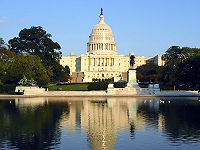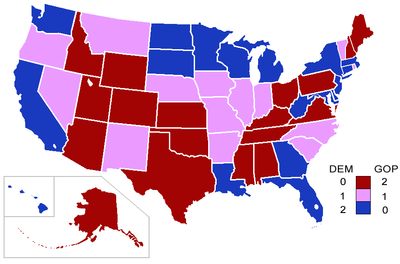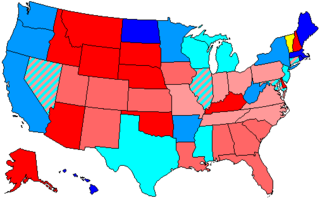- 107th United States Congress
-
107th United States Congress 
United States Capitol (2002)Duration: January 3, 2001 – January 3, 2003 Senate President: Al Gore (D)[1]
Dick Cheney (R)[1]Senate Pres. pro tem: Robert Byrd (D)
Strom Thurmond (R) [2]House Speaker: Dennis Hastert (R) Members: 100 Senators
435 Representatives
5 Non-voting membersSenate Majority: Democratic Party[2]
Republican PartyHouse Majority: Republican Party Sessions 1st: January 3, 2001 – December 20, 2001
2nd: January 23, 2002 – November 22, 2002<106th 108th> The One Hundred Seventh United States Congress was a meeting of the legislative branch of the United States federal government, composed of the United States Senate and the United States House of Representatives. It met in Washington, D.C. from January 3, 2001 to January 3, 2003, during the final weeks of the Clinton presidency and the first two years of the George W. Bush presidency. The apportionment of seats in this House of Representatives was based on the Twenty-first Census of the United States in 1990. The House of Representatives had a Republican majority, and the Senate switched majorities from Democratic to Republican and back to Democratic.
Major events
A rare even split in the United States Senate and the defection of a single Senator led to three changes in majorities. After the September 11 attacks, some Senators were targeted by anthrax attacks. Finally, the Congress voted to allow the President to attack Saddam Hussein in Iraq.
- January 3, 2001: Senate was evenly split, 50-50, between two parties. Democrat Al Gore was still Vice President giving the Democrats a slim majority for the 17 days between the January 3 swearing-in of the new Congress and the January 20 inauguration of Republican Vice President Dick Cheney. Hillary Rodham Clinton, wife of outgoing Democratic President Bill Clinton, became the first presidential spouse to serve in Congress.
- January 20, 2001: George W. Bush and Dick Cheney were sworn-in as President of the United States and Vice President of the United States, respectively, giving the Republicans a narrow majority in the Senate with Cheney's tie-breaking power.
- June 6, 2001: Senator Jim Jeffords, previously a Republican, declared himself an independent and announced he would join the Democratic caucus, giving Democrats control in the Senate with a one-seat advantage. Democrat Tom Daschle became Senate Majority Leader.
- September 11, 2001: September 11 attacks
- September 20, 2001: George W. Bush reported to a joint session of Congress on the investigation into the September 11 attacks and officially announces the War on Terrorism
- October 7, 2001: Operation Enduring Freedom began
- October 9, 2001: Anthrax attacks were executed against members of the Senate, including Senate Majority Leader Tom Daschle.
- December 2001: Corporate financial scandals, including Enron and MCI
- June 12, 2002: Prime Minister of Australia John Howard addressed a joint session of Congress. The address was originally scheduled for September 12, 2001, but was interrupted by the September 11 attacks. Already in Washington at the time, he sat in on Congressional sessions on September 12 instead.
Major legislation
- June 7, 2001: Economic Growth and Tax Relief Reconciliation Act, Pub.L. 107-16, 115 Stat. 38
- October 26, 2001: Uniting and Strengthening America by Providing Appropriate Tools Required to Intercept and Obstruct Terrorism ("USA PATRIOT") Act, Pub.L. 107-56, 115 Stat. 272
- January 8, 2002: No Child Left Behind Act, Pub.L. 107-110, 115 Stat. 1425
- January 11, 2002: Small Business Liability Relief and Brownfields Revitalization Act, Pub.L. 107-118, 115 Stat. 2356
- March 9, 2002: Job Creation and Worker Assistance Act, Pub.L. 107-147, 116 Stat. 21
- March 27, 2002: Bipartisan Campaign Reform Act (McCain-Feingold), Pub.L. 107-155, 116 Stat. 81
- May 13, 2002: Farm Security and Rural Investment Act of 2002, Pub.L. 107-171, 116 Stat. 134
- July 30, 2002: Sarbanes-Oxley Act, Pub.L. 107-204, 116 Stat. 745
- August 6, 2002: Trade Act of 2002, Pub.L. 107-210, 116 Stat. 933
- October 16, 2002: Authorization for Use of Military Force Against Iraq, Pub.L. 107-243, 116 Stat. 1497
- October 21, 2002: Sudan Peace Act, Pub.L. 107-245, 116 Stat. 1504
- October 29, 2002: Help America Vote Act, Pub.L. 107-252, 116 Stat. 1666
- November 25, 2002: Homeland Security Act, Pub.L. 107-296, 116 Stat. 2135
- December 17, 2002: E-Government Act of 2002, Pub.L. 107-347, 116 Stat. 2899
Party summary
Senate
Party (Shading indicates majority caucus)Total Notes Democratic Independent Republican Independence (MN) Vacant End of previous Congress 46 0 54 0 100 0 See United States Senate elections, 2000 Begin 50 0 50 0 100 0 Al Gore (D) was Vice President of the United States, with the tie-breaking vote. January 20, 2001 50 50 Dick Cheney (R) became Vice President of the United States, with the tie-breaking vote. June 6, 2001 50 1 49 James Jeffords switched from Republican to Independent and caucused with Democrats. October 25, 2002 49 99 1 Paul Wellstone (D) died. November 5, 2002 1 100 0 Dean Barkley (I-MN), who didn't caucus with either party, took Wellstone's seat. November 25, 2002 48 50 Jim Talent (R) took Jean Carnahan's (D) seat, but there was no reorganization as Senate was out of session.[3] November 30, 2002 49 99 1 Phil Gramm (R) resigned December 2, 2002 50 100 0 Senator-elect John Cornyn (R) was appointed to complete Gramm's term Final voting share 49% 50% 1% Beginning of the next Congress 48 1 51 0 100 0 See United States Senate elections, 2002 House of Representatives
Party (Shading indicates majority caucus)Total Republican Independent Democratic Vacant caucused with
Republicanscaucused with
DemocratsEnd of previous Congress 222 0 1 210 433 2 Begin 221 1 1 211 434 1 January 31, 2001 220 433 2 March 30, 2001 210 432 3 May 15, 2001 221 433 2 May 28, 2001 209 432 3 June 5, 2001 210 433 2 June 19, 2001 222 434 1 August 5, 2001 221 433 2 August 16, 2001 220 432 3 September 6, 2001 219 431 4 October 16, 2001 220 211 433 2 November 20, 2001 221 434 1 December 18, 2001 222 435 0 July 24, 2002 210 434 1 August 1, 2002 223 0 September 9, 2002 209 433 2 September 28, 2002 208 432 3 November 30, 2002 209 433 2 Final voting share 51.5% 48.5% Beginning of the next Congress 229 0 1 205 435 0 Leadership
Senate
- President of the Senate: Al Gore (D), until January 20, 2001
- Dick Cheney (R), from January 20, 2001
- President pro tempore: Robert Byrd (D), until January 20, 2001
- Strom Thurmond (R), January 20 – June 6, 2001
- Robert Byrd (D), from June 6, 2001
Majority leadership
- Majority Leader: Tom Daschle (D), until January 20, 2001
- Trent Lott (R), January 20 – June 6, 2001
- Tom Daschle (D), from June 6, 2001
- Majority Whip: Harry Reid (D), until January 20, 2001
- Don Nickles (R), January 20 – June 6, 2001
- Harry Reid (D), from June 6, 2001
Minority leadership
- Minority Leader: Trent Lott (R), until January 20, 2001
- Tom Daschle (D), January 20 – June 6, 2001
- Trent Lott (R), from June 6, 2001
- Minority Whip: Don Nickles (R), until January 20, 2001
- Harry Reid (D), January 20 – June 6, 2001
- Don Nickles (R), from June 6, 2001
House of Representatives
- Speaker: Dennis Hastert (R)
Majority (Republican) leadership
Minority (Democratic) leadership
- Minority Leader: Dick Gephardt
- Minority Whip: David E. Bonior, until January 15, 2002
- Nancy Pelosi, from January 15, 2002
Members
Senate
House of Representatives
Many of the congressional district numbers are linked to articles describing the district itself. Since the boundaries of the districts have changed often and substantially, the linked article may only describe the district as it exists today, and not as it was at the time of this Congress.
Further information: List of United States Congressional districtsSection contents: Alabama — Alaska — Arizona —Arkansas — California — Colorado — Connecticut — Delaware — Florida — Georgia — Hawaii — Idaho — Illinois — Indiana — Iowa — Kansas — Kentucky — Louisiana — Maine — Maryland — Massachusetts — Michigan — Minnesota — Mississippi — Missouri — Montana — Nebraska — Nevada — New Hampshire — New Jersey — New Mexico — New York — North Carolina — North Dakota — Ohio — Oklahoma — Oregon — Pennsylvania — Rhode Island — South Carolina — South Dakota — Tennessee — Texas — Utah — Vermont — Virginia — Washington — West Virginia — Wisconsin — Wyoming — Non-voting members Changes in Membership
Senate
State
(class)Former senator Reason for change Successor Date of successor's
installationVermont Jim Jeffords (R) Change of Party Affiliation Jim Jeffords
(I, caucused with Democrats)June 6, 2001 Minnesota Paul Wellstone (D) Wellstone died October 25, 2002. Governor Jesse Ventura appointed Barkley to serve the remaining two months of the term until Senator-elect Norm Coleman, who won the 2002 general election, was installed at the beginning of the next Congress. Dean Barkley (I) November 4, 2002 Missouri Jean Carnahan (D) As an appointed Senator, Carnahan served only until the election of an elected successor. Carnahan lost to Talent in the 2002 general election, and Talent was installed shortly thereafter Jim Talent (R) November 25, 2002 Texas Phil Gramm (R) Gramm resigned November 30, 2002 to give Senator-elect Cornyn advantageous office space. Governor Rick Perry appointed Cornyn in November 2002.[4] John Cornyn (R) December 2, 2002 House of Representatives
District Vacator Reason for change Successor Date of successor's
installationCalifornia 32nd Vacant Julian Dixon (D) died December 8, 2000, before the beginning of this Congress. A special election was held June 5, 2001. Diane Watson (D) June 5, 2001 Pennsylvania 9th Bud Shuster (R) Resigned, effective January 31, 2001. A special election was held May 15, 2001. Bill Shuster (R) May 15, 2001 Virginia 4th Norman Sisisky (D) Died March 30, 2001. A special election was held June 19, 2001. J. Randy Forbes (R) June 19, 2001 Massachusetts 9th Joe Moakley (D) Died May 28, 2001. A special election was held October 16, 2001. Stephen F. Lynch (D) October 16, 2001 Arkansas 3rd Asa Hutchinson (R) Resigned August 5, 2001 to head the Drug Enforcement Agency. A special election]] was held November 20, 2001. John Boozman (R) November 20, 2001 South Carolina 2nd Floyd Spence (R) Died August 16, 2001. A special election was held December 18, 2001. Joe Wilson (R) December 18, 2001 Florida 1st Joe Scarborough (R) Resigned, effective September 6, 2001. A special election was held October 16, 2001. Jeff Miller (R) October 16, 2001 Oklahoma 1st Steve Largent (R) Resigned, effective February 15, 2002, to concentrate on his campaign for Governor. A special election was held January 8, 2002. John Sullivan (R) February 15, 2002 Ohio 17th Jim Traficant (D) Expelled July 24, 2002 for criminal conviction of 10 counts of bribery, racketeering, and tax evasion. Vacant Not filled for remainder of Congress Virginia 5th Virgil Goode (I) Changed Party Affiliation Virgil Goode (R) August 1, 2002 Ohio 3rd Tony P. Hall (D) Resigned September 9, 2002 after he was appointed to be the U.S. Ambassador to the United Nations Food and Agriculture Organization. Vacant Not filled for remainder of Congress Hawaii 2nd Patsy Mink (D) Died September 28, 2002 but was elected posthumously on November 5, 2002. Ed Case (D) November 30, 2002 Employees
- Architect of the Capitol: Alan M. Hantman
- Attending Physician of the United States Congress: John F. Eisold
Senate
- Chaplain: Lloyd John Ogilvie
- Historian: Richard A. Baker
- Parliamentarian:
- Bob Dove
- Alan Frumin
- Secretary:
- Gary Lee Sisco, until July 11, 2001
- Jeri Thomson, July 12, 2001 - end
- Sergeant at Arms:
- James W. Ziglar, until September 3, 2001
- Alfonso E. Lenhardt, September 4, 2001 - end
- Secretary for the Majority / Minority:
- Martin P. Paone (Democrats)
- Elizabeth B. Letchworth (Republicans)
- David J. Schiappa (Republicans)
House of Representatives
- Chaplain: Daniel P. Coughlin
- Chief Administrative Officer:James M. Eagen, III
- Clerk: Jeff Trandahl
- Historian: Vacant
- Parliamentarian: Charles W. Johnson
- Reading Clerks:
- Mary Kevin Niland (D)
- Paul Hays (R)
- Sergeant at Arms: Wilson Livingood
- Inspector General: Steven McNamara
References and external links
- ^ a b Al Gore served until his terms ended at noon on January 20, 2001, when Dick Cheney was sworn in and his term began.
- ^ a b When the Congress began, the Senate was divided 50-50. Because the Vice President's tie-breaking vote would change control from Democrats to Republicans on January 20, the Senate elected Byrd to serve until noon and Thurmond to serve from noon on January 20. Control changed again from June 6, 2001, when Jim Jeffords left the Republican Party and Byrd was once again elected President pro tempore. For details, see party summary > Senate, on this page.
- ^ Party Division in the Senate, 1789-Present, via Senate.gov
- ^ senate.gov
 This article incorporates public domain material from websites or documents of the Biographical Directory of the United States Congress.
This article incorporates public domain material from websites or documents of the Biographical Directory of the United States Congress.- "MINERVA" Project - 107th Congress Library of Congress web archives
- "Thomas" Project
- Art & History, via U.S. House of Representatives
- Statistics and Lists, via U.S. Senate
United States Congresses (and years begun) 111 (2009)
112 (2011)
113 (2013)Categories:
Wikimedia Foundation. 2010.



